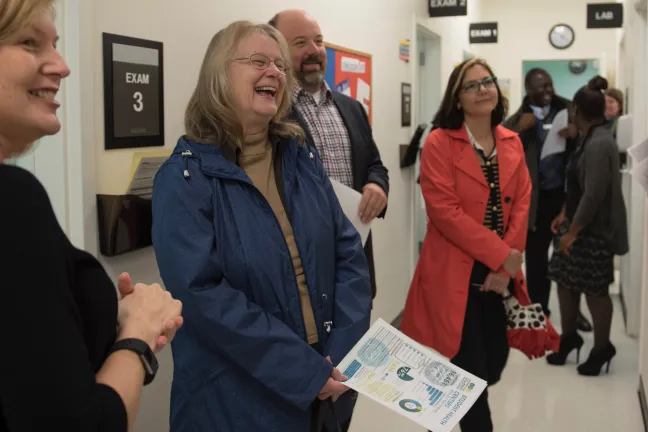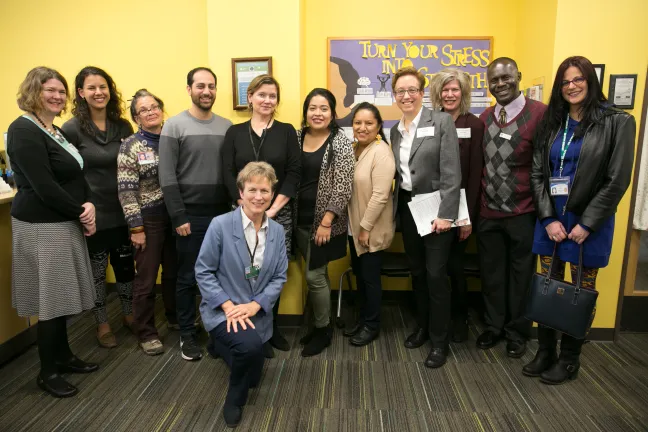Student Health Centers in Multnomah County opened their doors this fall to the state lawmakers who vote on whether, and at what level, to support Oregon’s 76 school-based primary care clinics.
“I know how valuable this is,” Sen. Laurie Monnes-Anderson, of Portland, said during a recent tour of Centennial High School’s health center, the newest of the county’s 12 school-based clinics. “There is such a need. Such a need.”
Indeed, if contraception is a bellwether of students’ access to healthcare, the state has come a long way since school-based primary care clinics first opened across Oregon in the 1980s.
When Laurie Monnes-Anderson took a job as a nurse at Oregon City High School in 1986, she wasn’t allowed to discuss birth control, she said. When a teen would ask her about options, Monnes-Anderson would arrange to meet the student off school grounds at a clinic where she could openly discuss it. Within three years of quiet counseling, the number of pregnant teens at her school dropped from 21 to 9.
Multnomah County’s clinic in Roosevelt High School opened in 1986 amid an outcry from parents who opposed teens accessing birth control. Since then, the county has opened 11 other clinics at schools in David Douglas, Parkrose, Centennial and Portland Public School Districts, where staff offer full primary care services to nearly 6,500 young people each year. Today all health centers provide counseling and education about abstinence, safe sex to options for birth control.
Any youth, from kindergarten-age through high school-age, can visit a Student Health Center, regardless of whether they attend classes. And no one is turned away for an inability to pay. “The concept is to break down barriers,” said Alexandra Lowell, director of the student health centers. “Some youth don't have insurance. Others are concerned about confidentiality. And we work with them to make sure they get what they need. We want kids to be healthy so they can focus on school.”
The program budget is more than $6 million a year. The state invests $60,000 for the first center in each county, and $56,000 for each additional center. Many students are enrolled in the Oregon Health Plan, and some have private insurance, which is the primary revenue stream for the health center costs. And federal grants also make a significant contribution. The county general fund pays for what is not otherwise covered, about 25 to 30 percent of the total cost.
"When we invest in the physical and mental health of our kids, we're investing in our community and in our future,” said Multnomah County Chair Deborah Kafoury. “We do this work because we want to change the world. We need to invest in the leaders who will carry on that work."
Last year staff recorded 16,461 visits; the most common of which was to complete an annual physical. Birth control was also a common request. Meanwhile demand for mental and behavioral health services have grown. Nearly 1,000 students were referred to mental health services last year, and nearly a third enrolled in counseling.
Senator Monnes-Anderson said she constantly hears about the need for more mental health services. “We’re short on mental health everywhere,” she said. “We’ll come back fighting for more funding.”
Multnomah County has added behavioral health specialists at three sites to help students struggling with behavior or social issues such as academics, sleep, weight or smoking. Unlike Mental health providers, who carry a caseload and provide traditional therapy, behavioral health providers are available for students who need immediate help. Perhaps it’s a student struggling in class or who has low self-esteem. Without them, a student might have to wait to speak to one of mental health providers, who often booked weeks out, even if the student doesn’t necessarily need ongoing therapy.
One of those behavioral health specialists is Joanne Serna, who works at two sites. She told Monnes-Anderson that it frees up nurse practitioners to focus on medical needs, and frees mental health providers to focus on the longer-term needs of their clients.
Across town, Tina Kotek, speaker of the Oregon House of Representatives, toured the renovated health center at Roosevelt High School, where students began a weekly lunch club with clinic staff. “They just feel this is a safe place,” clinic staffer Lidia Rodriguez told Kotek.
Kotek too said she has increasingly heard of a need for mental health services, and she said she hopes voters pass Measure 101 in January to further extend healthcare to low-income Oregonians.
“Mental health is an issue every time I visit schools,” she said. “There’s a lot of trauma in our schools, a lot of homelessness, kids couch-surfing, LGBT issues.”
Galen Cohen, a mental health provider at Roosevelt, sees up to six students each day. He said in the five years he’s been at Roosevelt, he has seen an increasing number of kids who identify as transgender or non-binary. That’s in large part, he believes, because students trust the clinic staff.
“It’s one of the safest places for these kids,” he said. “Once students find out providers understand and are accepting, word spreads.”


